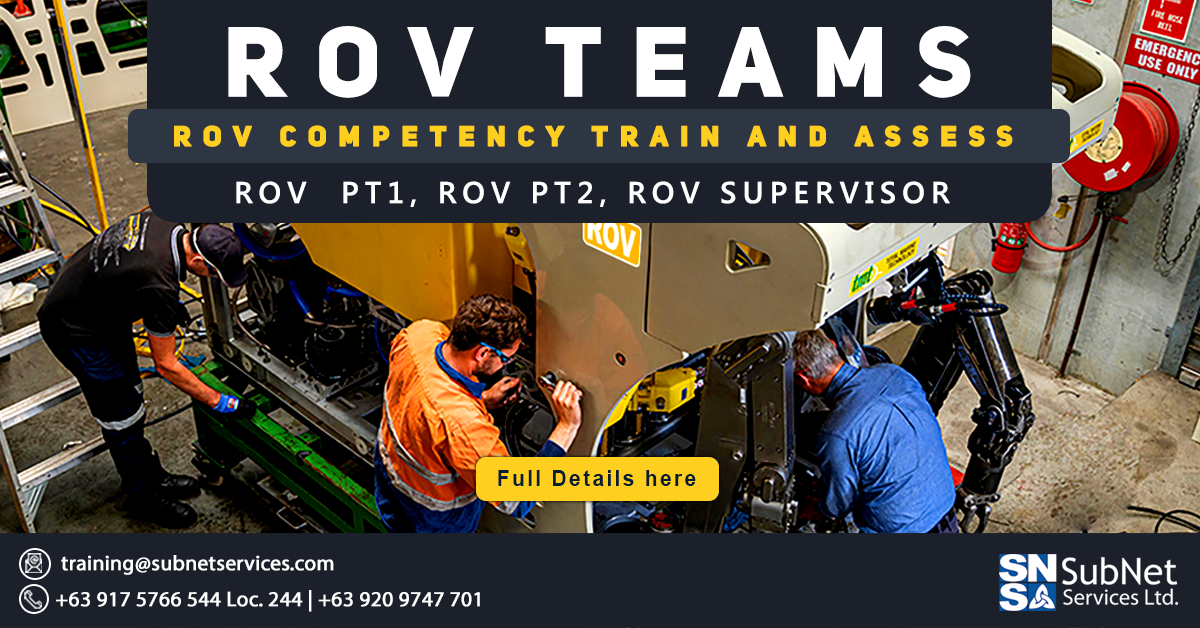Into the Sea: Taking a Deeper Look at ROVs
SubNet Services is known to be the first company to ever provide the Remotely Operated Vehicle (ROV) Pilot Technician Course in the Philippines. We have been offering this course, along with other related trainings, to help aspiring ROV personnel penetrate the exciting and high paying ROV industry.
For better guidance, we have also created a career path document for aspiring ROV Pilot Technicians. You may check SubNet Services Career Path for an ROV Pilot Technician to learn more. You may even watch SubNet Services ROV Training video, or check our list of ROV training programs to make yourself familiarized with each course. Once you have chosen your preferred training, you may opt to book your ROV course right away.
But for this feature, let us have a further discussion about ROVs. What are they really like? When and where did they originate? How are they operated? What are their uses? Let us find these things out, as we take a deeper look at these underwater robots.
ROVs at First Glimpse
ROVs refer to tethered underwater robots that are unoccupied, highly maneuverable, and operated by a person aboard a vessel. They are basically linked to the ship by a tether (sometimes referred to as an umbilical cable), a group of cables that carry electrical power, video, and data signals back and forth between the operator and the vehicle. High power applications will often use hydraulics in addition to electrical cabling.
Most ROVs are equipped with at least a video camera and lights. Additional equipment is commonly added to expand the vehicle’s capabilities. These may include sonars, magnetometers, a still camera, a manipulator or cutting arm, water samplers, and instruments that measure water clarity, light penetration, and temperature.
A Look Back in History
It was Dimitri Rebikoff (a French scientist, engineer, and explorer) who invented the first ROV in 1953 called “Poddle”. However, it was in 1960s when ROVs were first put to test. The US Navy’s “Cable-controlled Underwater Recovery Vehicle” (CURV) successfully recovered a missing atomic bomb off the coast of Spain.
According to “The ROV Manual: A User Guide for Observation-Class Remotely Operated Vehicles” by Robert D. Christ and Robert L. Wenli Sr., the US Navy kept on making advancements in the ROV industry following CURV’s success. In 1974, 20 ROVs were made available, 17 of which were government owned. In 1982, there were 500 ROVs, many of which were commercially owned. And finally in 1998, there were more than 3000 ROVs worldwide.
Keeping an Eye on ROVs
The movement of ROVs are basically controlled from a ship’s cabin or other indoor location on the surface by an ROV Pilot Technician. His job description, nonetheless, can be either of the following:
- Launches and flies the ROV by remote control from the surface of the water
- Operates equipment like cameras and interprets data to calculate and keep track of the position of the ROV
- Navigates the ROV’s route and avoids hazards such as moving parts of the ship
- Operates robotic arms of the ROV to perform simple tasks such as picking up items from the seabed
- Judges the changing weather conditions and if necessary, alters the dive program at a short notice
- Relays information during the dive and verbally uses video equipment and computer
- Regularly maintains the ROV and its associated equipment and carries out repairs on location
- Performs technical tasks such as rigging and operating small boats and basic electronic and hydraulic construction
- Writes technical reports and orders spare parts
Eye to Eye with ROVs
Undeniably, ROVs have many benefits in different industries. Some of which are as follows:
- Aquaculture – ROVs are used in aquaculture to make net inspections, lighting, feeding, trouble shooting, and stock monitoring easier and more efficient.
- Commercial and Salvage Diving – ROVs are used in commercial and salvage diving to ensure a higher level of diver safety.
- Environmental Research – ROVs are used in environmental research to provide a cost-effective alternative to make use of research grants and funding.
- Military – ROVs are used in military to offer a safer view of threats and evidence that is hidden beneath the waves, without jeopardizing diver’s safety.
- Municipal Infrastructure – ROVs are used in municipal infrastructure to perform inspections of pipeline systems and to ensure the safety of divers.
- Oil and Energy – ROVs are used in oil and energy as an alternative to sending divers underwater to perform periodic monitoring and inspection.
- Search and Rescue Operations – ROVs are used in SAR operations to enable these robots to go to great depths, locate critical areas, perform in harsh conditions, and allow divers to remain rested until they are needed during the rescue process.
- Shipping – ROVs are used in shipping to provide an affordable, user-friendly way to perform marine surveys, hull and ship inspections, and ballast tank inspections without the need for diver intervention.
- Underwater Discovery – ROVs are used in underwater discovery to mitigate risks and help divers with imaging and video recording capabilities.
For further reference, you may check our blog article on the Recent Rediscoveries (and Discoveries) through the Use of ROVs.
All in all, the importance of ROVs is not something anyone can overlook. These robots literally perform miracles in places that can no longer be penetrated by humans and at times when lives are put at stake. If you are interested to know more about ROVs, please watch out for future posts about the different classes of ROVs, as well as key features required by an ROV during SAR missions.
For further inquiries about our trainings, you may Contact or Email our Customer Sales Team.
Be trained and internationally certified!
Only here at SubNet Services.
Sources:
– Deep Trekker. “What Are Underwater ROVs & What Are They Used For?”. www.deeptrekker.com. https://www.deeptrekker.com/underwater-rovs/ (accessed May 25, 2018)
– Planit. “ROV Pilot Technician”. www.planitplus.net. https://www.planitplus.net/JobProfiles/View/730/53 (accessed May 25, 2018)
– The Mariners’ Museum and Park. “The Ages of Exploration – ROV”. exploration.marinersmuseum.org. http://exploration.marinersmuseum.org/object/rov/ (accessed May 25, 2018)



